Modernizing Huestis Hall at the University of Oregon
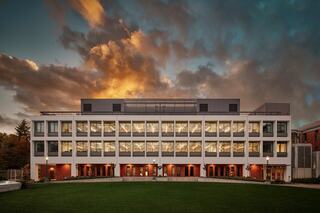
Built in the early 1970s, Huestis Hall became the seventh science building at the University of Oregon’s growing Lorry I. Lokey Science Complex. For decades, it has continued to serve as a teaching and research hub for biological sciences. It’s home to the University’s Institute of Neuroscience, responsible for groundbreaking research in brain plasticity, neural mechanics of attention shifting, the impact of psychedelics on brain function and much more.
Over time, the building’s aging exterior and lack of a prominent main entrance has diminished Huestis Hall. The building’s interior mirrored the exterior’s condition, with finishes and utilities that were outdated and in poor condition. The layout of the research spaces also hindered the creation of an open, collaborative research environment. Additionally, the building no longer met contemporary standards for accessibility, MEP infrastructure, energy efficiency and seismic safety.
To transform Huestis Hall into a more resilient, modern and collaborative research facility, the University of Oregon embarked on a major renovation spanning 60,000 square feet across four stories with extensive seismic upgrades and a comprehensive overhaul of all the significant systems, including HVAC, plumbing, fire protection and electrical systems. Project design was headed by TVA Architects, with MEP design by Systems West Engineers, civil engineering by KPFF and structural engineering by Catena.
Completing seismic upgrades
Lewis inherited the project from another general contractor during the demolition phase. Drawing on decades of experience and over 50 past projects on campus, including prior work in Huestis Hall, Lewis quickly adapted to the challenges, including the need for complex seismic structural upgrades, keeping basement research labs operational and managing pre-existing conditions.
When considering how to implement seismic upgrades to the building, the project team concluded that adding shear walls would have been too disruptive to the Zebrafish Laboratory and the Lokey Laboratory in the basement. Instead, the team decided to utilize fiber-reinforced polymer (FRP), a composite material consisting of fibers embedded in resin, to provide strength and stiffness.
Built in the early 1970s, Huestis Hall became the seventh science building at the University of Oregon’s growing Lorry I. Lokey Science Complex. For decades, it has continued to serve as a teaching and research hub for biological sciences. It’s home to the University’s Institute of Neuroscience, responsible for groundbreaking research in brain plasticity, neural mechanics of attention shifting, the impact of psychedelics on brain function and much more.
Over time, the building’s aging exterior and lack of a prominent main entrance has diminished Huestis Hall. The building’s interior mirrored the exterior’s condition, with finishes and utilities that were outdated and in poor condition. The layout of the research spaces also hindered the creation of an open, collaborative research environment. Additionally, the building no longer met contemporary standards for accessibility, MEP infrastructure, energy efficiency and seismic safety.
To transform Huestis Hall into a more resilient, modern and collaborative research facility, the University of Oregon embarked on a major renovation spanning 60,000 square feet across four stories with extensive seismic upgrades and a comprehensive overhaul of all the significant systems, including HVAC, plumbing, fire protection and electrical systems. Project design was headed by TVA Architects, with MEP design by Systems West Engineers, civil engineering by KPFF and structural engineering by Catena.
Completing seismic upgrades
Lewis inherited the project from another general contractor during the demolition phase. Drawing on decades of experience and over 50 past projects on campus, including prior work in Huestis Hall, Lewis quickly adapted to the challenges, including the need for complex seismic structural upgrades, keeping basement research labs operational and managing pre-existing conditions.
When considering how to implement seismic upgrades to the building, the project team concluded that adding shear walls would have been too disruptive to the Zebrafish Laboratory and the Lokey Laboratory in the basement. Instead, the team decided to utilize fiber-reinforced polymer (FRP), a composite material consisting of fibers embedded in resin, to provide strength and stiffness.
FRP is often chosen over traditional shear walls for seismic reinforcement of buildings because it offers several distinct advantages. FRP materials are lightweight, which means they can seismically reinforce a building without adding extra weight to the existing structure.
Additionally, FRP can be applied directly to existing surfaces with minimal disruption, making it a faster and less invasive option compared to constructing new shear walls, which often require significant modifications.
Ultimately, Huestis Hall became the first building on campus to use FRP. Despite its versatility, FRP installation would prove immensely challenging, given the building’s layout. Crews coated the elevator core and stairwell walls with strips of FRP from the basement to the roof.
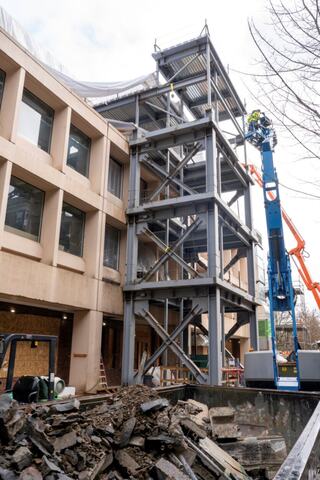
Figure 1: A new elevator shaft being added to building exterior.
The existing elevator had to be completely removed so the FRP could be applied inside the concrete shaft. A new elevator tower was also added, built with steel brace frames to provide lateral stability (Figure 1). The team also faced challenges in the stairwells, where the build-up of FRP resin along the base of the walls required deep collaboration amongst the UO, TVA, and Lewis to develop an architectural solution (Figure 2). The team ultimately decided on a plaster skim coat, which required careful design and installation to meet aesthetic demands while providing enough space to meet egress requirements in the stairwells.
Building in occupied spaces
Minimizing disruption to Huestis Hall users was a huge priority. While classes were moved out of the building throughout the duration of the project, the Zebrafish facility in the basement had to remain occupied and operational. The lab director was in daily contact with Lewis to ensure everyone was on the same page regarding any potential impacts to the lab and to coordinate power and water shutdowns.
One example of this level of collaboration between Lewis and the lab took place in January 2024 when extreme ice storms shut down the university and caused widespread power outages. Lewis worked with the lab director to keep electrical and mechanical units running and maintain lab operations. This effort required Lewis staff to work in shifts emptying drain buckets every 12 hours for five days to ensure research was not impacted.
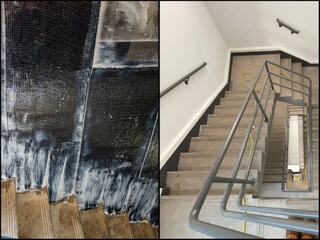
Figure 2: FRP resin build up before and after in the building’s stairwells.
Early in the project, a central challenge was consistently getting fresh air into the basement during construction for lab operations. Lewis Superintendent Vince Kennedy worked with the lab director to design and install a 50-foot-tall fresh air intake unit called the Snorkel that fed air from the building’s exterior into the basement (Figure 3). The collaboration between the university staff and Lewis was key to the project success. It was a constant reminder of the advantages of having a long history working on the campus and having earned the building users’ trust.
Adapting to pre-existing conditions
The relationships built with the client and building users helped when unforeseen conditions complicated the renovation.
Water damage to the building’s facade was one such example. To maintain the historical brick veneer features, Lewis dismantled and reconstructed the veneer using restored original bricks.
The team also discovered a large opening in the basement concrete wall that was being utilized for ductwork and piping. This opening was not shown on any of the project’s original drawings and impacted the overall structural design. Ultimately, this led to a redesign of the HVAC and fire protection systems and added work in the occupied Zebrafish lab.
The end result: a seismically-resilient and modern hub for bioscience
The renovation of Huestis Hall stands as a testament to the power of trust, local expertise and innovation. Through meticulous planning and creative problem-solving, the project team successfully overcame numerous challenges to revitalize a crucial research facility on schedule and under budget. This project not only preserved the building’s character but also equipped it with a safe, modern, aesthetically pleasing research environment, ensuring it continues to fuel scientific discovery and education for years to come (Figure 4).
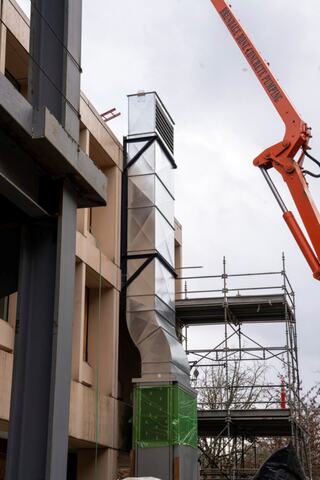
Figure 3: The Snorkel. A project team innovation that provided fresh air into the basement lab space during construction.
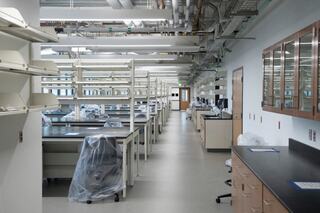
Figure 4: Finished open research lab spaces where multiple labs will collaborate together.